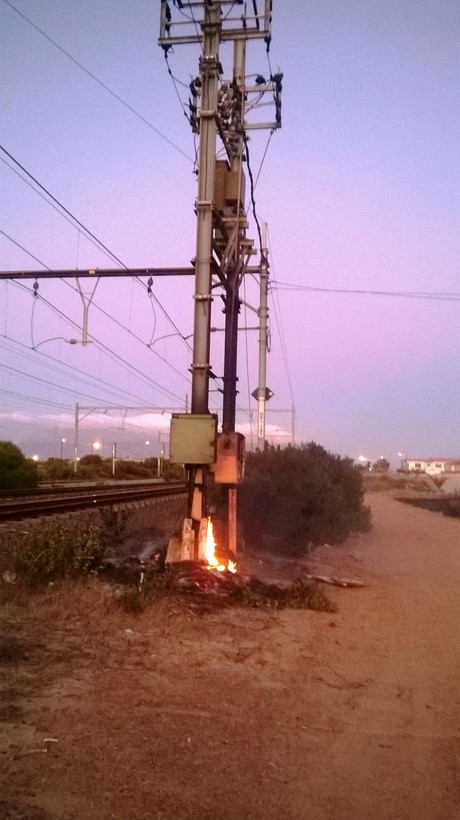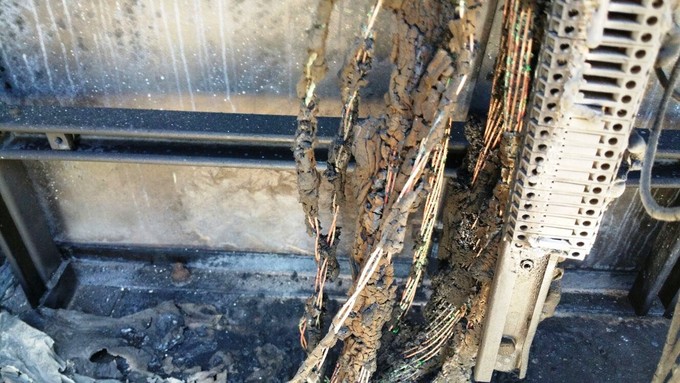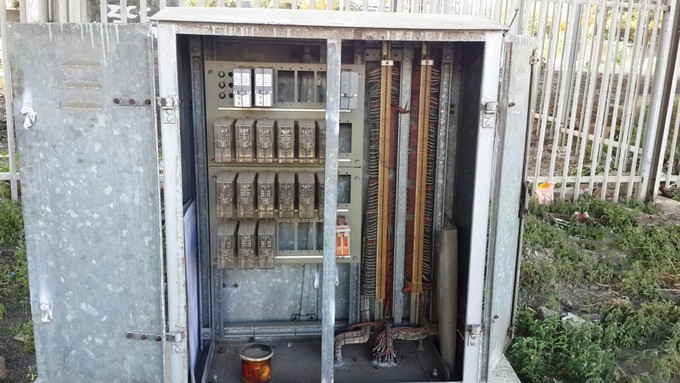
Metrorail coaches caught fire at Glencairn in January 2015. Photo courtesy of Metrorail
11 February 2016
Every day, Cape Town’s long-suffering commuters face delays on Metrorail trains. And every day Metrorail offers a set of reasons for the delays. Defective signal equipment, defective “sets”, “technical problems”, cable theft: there seems to be no end to the problems facing Metrorail. Siyavuya Khaya asked spokesperson Riana Scott to explain.
GroundUp: Are the trains too old?
Scott: It is true that our infrastructure and trains have reached the end of their design lifespan. People who used to run Metrorail before 1994 never really maintained the infrastructure. The last new train was bought in 1986 and it was placed on the Khayelitsha line as it is one of the busiest lines.
GroundUp: What about the tracks?
Scott: There is only one company in the whole world that manufactures the tracks. And the company is in Austria and you need to book in September if you want them tracks and if you miss that deadline you have wait for next year. Sometimes it can take months or years to get your order. When the tracks reach Cape Town, we have to book a specialised rail truck called a bolster truck from Transnet to transport the tracks to us. It is the only truck in South Africa that can transport the tracks. Sometimes the truck is fully booked and we have to wait until it is our turn. And we can’t buy our own truck because it is very expensive and not fully productive.
GroundUp: Do you have trained people to repair the tracks?
Scott: The process of installing new tracks is done manually and that also consumes lot of time and money. A track grinder and tamping machine has to be rented from Transnet to grind the tracks and to stabilise the ballast stone beneath the tracks.
GroundUp: What is a “defective set”?
Scott: A defective set means there is a problem with the train. That could be anything. Maybe there are some wires that have not been well tightened. You know how, when you drive an old car, you park it in your garage and the next morning it does not start. And you don’t know what the problem is because it is a skorokoro. That is what we mean when we say there is a defective set. A train in other words is a set. Sometimes there is problem with the Pantograph (the apparatus which connects the train to the overhead electricity supply).

GroundUp: What is a “signal failure” and is it caused by vandalism?
Scott: There are signalling boxes built next to the railway tracks which help our staff monitor the trains to ensure that that trains operate safely. Wires contained in the large apparatus cases alongside the tracks regulate signals. These wires contain copper and are targeted by vandals. As soon as these are vandalised, the signals stop functioning and trains have to be authorised manually by an operator in the control centre.
Points machines (small boxes along the tracks) help the train change tracks. These are often disabled by placing stones between the points, preventing the train from operating on its course. Inside the apparatus box there are small copper wires and people vandalise these by smashing the box with a hammer. Often people throw objects like shoes over the overhead wires to short out the electricity, so protecting themselves from electrocution.
Our technicians pick up the problem and attend to the problem as quickly as possible and that is the best solution we have.
GroundUp: Why are the trains on the Kraaifontein and Khayelitsha lines delayed so often?
Scott: Philippi station is the main station that connects Khayelitsha and Mitchell’s Plain and most of the vandalism occurs at that station. Trains that go to Khayelitsha and Mitchell’s Plain go via Philippi. If there is damage at that station then all trains are brought to a standstill. North of Kraaifontein, Metrorail operates on tracks owned by Transnet. And if there is a fault on those tracks, the trains won’t work until the tracks are fixed by Transnet. Transnet does not have technicians here in Cape Town and the technicians come from Beaufort West or Touws River.
GroundUp: What other challenges do you face?
Scott: People build their shacks next to the railways. The tracks have electricity and if people connect electricity from other communities and put their wires underneath the tracks that stops the signalling system functioning well. It is a long legal process to relocate informal settlers to alternative serviced land.
On the Simonstown line, the bulk removal of sand often requires permission from environmental agencies. There are syndicates that steal the copper and there are people who steal the copper just to feed their families, and others steal to buy drugs.
Finally, we don’t have a short term solution for peak hour demand and overcrowding on the trains. The return of all the carriages destroyed by fire will alleviate pressure during peaks. This is unfortunately a time consuming process
GroundUp: How many trains do you have operating in Cape Town and where do you fix them when there are problems?
Scott: In Cape Town we must have 89 train-sets operating and six on stand-by. Thirty-three of these sets are deployed on the Khayelitsha line because it is one of the busiest lines. And the number of trains we have is not enough. One train-set makes about six trips per day. There are currently about four companies in South Africa that repair trains. It costs about R1 million to repair a carriage, so we urge people not to burn them.


GroundUp: What are you planning to do to fix the problems?
Scott: As part of PRASA’s modernisation programme, a beautiful new station in Philippi is nearly completed. We are just making some final touch ups before we officially open it. This is one of the efforts we are making to improve our infrastructure and we are going to revamp other stations as well. We are also planning to revamp the Salt River depot in preparation for new trains.
Investment in rail over the past 19 years, from 1991 to 2010, amounted to R14 billion to maintain the infrastructure. Modernisation will require the equivalent to be spent annually over the next 20 years to completely overhaul and modernise the rail system and its supporting infrastructure. Modernisation is funded through capital investment guaranteed by government while operational costs are covered by fares and government subsidy.
GroundUp: What are your long term plans?
Scott: We have one train that has just arrived from Brazil. It is in Johannesburg for testing and once approved, more will follow until the South African factory can produce the trains locally. Five trains are planned for Cape Town initially, estimated delivery between 2017 and 2018. The new trains are going to have onboard announcement capability, something current trains do not have. We will need to train and equip our staff with new skills for the new trains. By 2034 we aim to have everything operating smoothly.
GroundUp: And in the short term?
Scott: Every afternoon we have a teleconference to assess how the morning peak service fared and to prepare for the afternoon peak. Our technicians are on standby 24/7 and we always aim to fix the problems as soon as possible. We urge people not to damage the old skorokoro trains we have because that just puts more pressure on us.